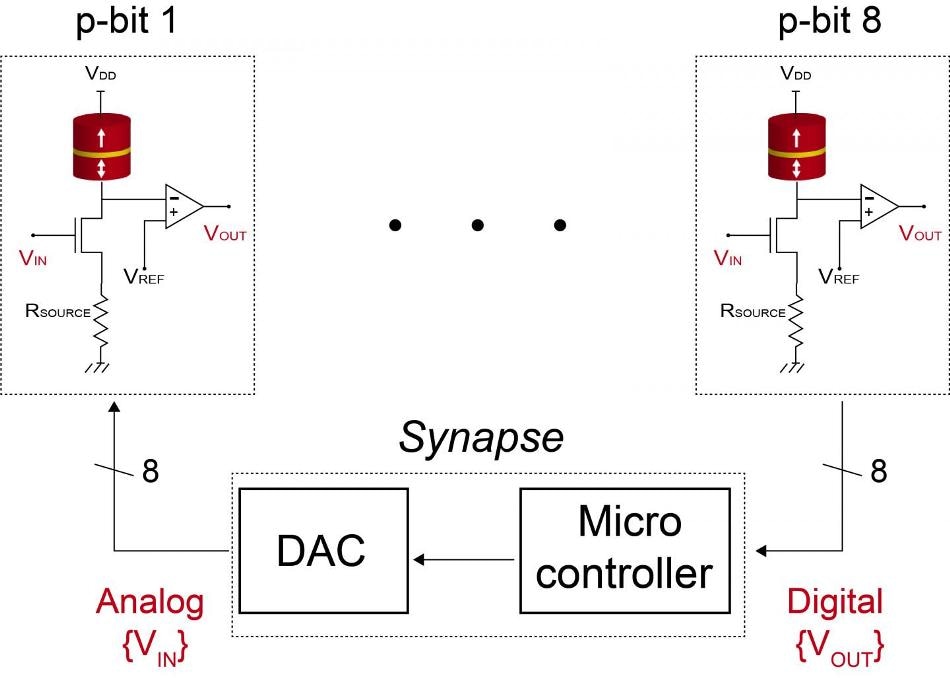Sep 19 2019
Many more decades may pass before quantum computers get ready to find solutions to problems that existing classical computers are not efficient or fast enough to solve. However, the evolving “probabilistic computer” could close the gap between quantum and classical computing.
 For the first time, researchers have demonstrated a way to build a probabilistic computer. This circuit includes a modified version of a magnetoresistive random-access memory device (red) to interconnect eight p-bits. (Image credit: Purdue University/Ahmed Zeeshan Pervaiz)
For the first time, researchers have demonstrated a way to build a probabilistic computer. This circuit includes a modified version of a magnetoresistive random-access memory device (red) to interconnect eight p-bits. (Image credit: Purdue University/Ahmed Zeeshan Pervaiz)
Engineers from Purdue University and Tohoku University in Japan have developed the first-ever hardware to show how the basic units of what would be a probabilistic computer—known as p-bits—have the capability to perform a calculation that only quantum computers can perform.
The research, reported in Nature on Wednesday, September 18th, 2019, describes a device that acts as a basis for developing probabilistic computers to solve problems more efficiently in areas like encryption and cybersecurity, drug research, data analysis, financial services, and supply chain logistics.
Present-day computers store and use information in the form of zeroes and ones, known as bits. By contrast, qubits are used by quantum computers. The qubits can be both zero and one at the same instance.
In 2017, a Purdue research team under the guidance of Supriyo Datta, the university’s Thomas Duncan Distinguished Professor of Electrical and Computer Engineering, put forward the concept of a probabilistic computer that used p-bits, which can be either zero or one at any specified instance and quickly fluctuate between the two.
There is a useful subset of problems solvable with qubits that can also be solved with p-bits. You might say that a p-bit is a ‘poor man’s qubit’.
Supriyo Datta, Thomas Duncan Distinguished Professor of Electrical and Computer Engineering, Purdue University
In contrast to qubits that require extremely cold temperatures to function, p-bits operate at room temperature similar to existing electronics. Therefore, it would be possible to adapt today’s hardware to develop a probabilistic computer, stated the researchers.
The researchers developed a device that is an altered version of magnetoresistive random-access memory (MRAM), which is used in certain types of computers at present for information storage. The technology involves using the magnets’ orientation to form states of resistance corresponding to zero or one.
Tohoku University scientists William Borders, Shusuke Fukami, and Hideo Ohno modified an MRAM device, rendering it unstable deliberately to better promote the potential of p-bits to fluctuate. Researchers from Purdue University integrated this device with a transistor to develop a three-terminal unit with controllable fluctuations. To create a probabilistic computer, they interconnected eight such p-bit units.
The circuit was successful in solving what is usually regarded as a “quantum” problem: Factoring, or breaking down, numbers like 35,161 and 945 into smaller numbers, a calculation called integer factorization. Existing classical computers are quite capable of performing these calculations; however, the scientists believe that the probabilistic approach described in this study would require considerably less energy and space.
On a chip, this circuit would take up the same area as a transistor, but perform a function that would have taken thousands of transistors to perform. It also operates in a manner that could speed up calculation through the parallel operation of a large number of p-bits.
Ahmed Zeeshan Pervaiz, PhD Student, Electrical and Computer Engineering, Purdue University
In reality, hundreds of p-bits would be required to solve bigger problems—however, according to the researchers, that is not very far.
In the near future, p-bits could better help a machine to learn like a human does or optimize a route for goods to travel to market.
Kerem Camsari, Postdoctoral Associate in Electrical and Computer Engineering, Purdue University
The Purdue team collaborates with the Discovery Park Center for Computing Advances by Probabilistic Spin Logic headed by Joerg Appenzeller. The Purdue Research Foundation Office of Technology Commercialization has filed a patent application for this technology.
The study was partly funded by the Defense Advanced Research Projects Agency, the Semiconductor Research Corp., the Japan Society for the Promotion of Science, the Research Institute of Electrical Communication of Tohoku University, and Japan’s Council for Science, Technology and Innovation.